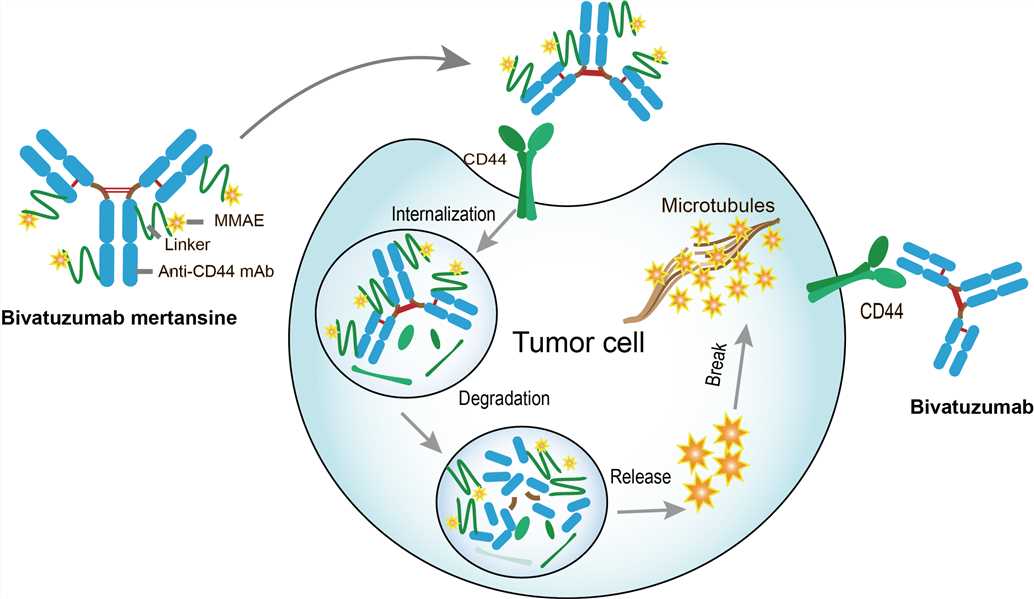

Bivatuzumab Overview
Introduction of Bivatuzumab
Bivatuzumab, previously known as BIWA 4, is an IgG type humanized monoclonal antibody targeted CD44. CD44 is a widely distributed transmembrane glycoprotein on the surface of cells. Its expression can be detected on the surface of lymphocytes and fibroblasts. Bivatuzumab was developed by Boehringer Ingelheim and has been used in the treatment of head and neck cancer. Head and neck carcinoma, also known as head and neck squamous cell carcinoma, mainly originated from the upper respiratory tract and upper digestive tract mucosa, 200000 new cases worldwide every year. The main treatment methods of head and neck cancer are radiotherapy, chemotherapy, targeted therapy, and surgical treatment. With the development of molecular research in head and neck cancer, targeted drug therapy has gradually become an advantage in head and neck cancer. Because bivatuzumab can specifically target CD44 antigen on the cell surface, it is often conjugated with chemical drugs to form specifically targeted drugs for anti-tumor research.
Mechanism of Action of Bivatuzumab
CD44 is a highly heterogeneous cell surface transmembrane glycoprotein with a molecular weight of about 80 kDa-200 kDa. The extracellular domain of CD4-4 has the ability to bind to hyaluronic acid and is also an important region for its biological function. The transmembrane region of CD44 is composed of 21 hydrophobic amino acids, and the cytoplasmic region can be phosphorylated by protein kinase C (PKC), which is involved in intracellular signal transduction. According to the expression of an exon, CD44 can be divided into standard CD44 (CD44s) and variant CD44 (CD44v). CD44v mainly occurs in the pathological process of the body, in which CD44v6 plays an important role in tumor progression. CD44v mainly occurs in the pathological process of the body, in which CD44v6 plays an important role in tumor progression. Researched found that CD44v6 can promote the adhesion of tumor cells to basement membrane adhesion protein and IV collagenase, and create conditions for the degradation of the extracellular matrix. As a receptor mediating the binding of HA to cytoskeleton protein, CD44v6 is involved in the formation of pseudopodium, which leads to the changes of cell morphology and migration, and promotes the metastasis of cancer cells. Cancer cells with high expression of 3CD44v6 can obtain lymphocyte camouflage and escape the recognition and killing of the immune system. CD44v6 can also promote the release of proteolytic enzymes from tumor stromal cells. In addition, CD44v6 has been used as a marker to judge the metastasis of liver cancer, breast cancer, colorectal cancer, and gastric tumor. Bivatuzumab can specifically target CD44v6, and mediate internalization. Therefore, bivatuzumab is an ideal monoclonal antibody for the treatment of some cancers, which used CD44 molecular as therapy targeted. So it often binds to cytotoxic effector molecules to form an antibody-drug conjugate with anti-tumor activity.

Fig 1. Mechanism of Action of Bivatuzumab
What We Provide
Therapeutic Antibody
Bivatuzumab
We provide high-quality Bivatuzumab for use in WB, FC, IP, ELISA, Neut, FuncS, IF and most other immunological methods. For lab research use only, not for diagnostic, therapeutic or any in vivo human use.
For research use only. Not intended for any clinical use.
This site is protected by reCAPTCHA and the Google Privacy Policy and Terms of Service apply.

